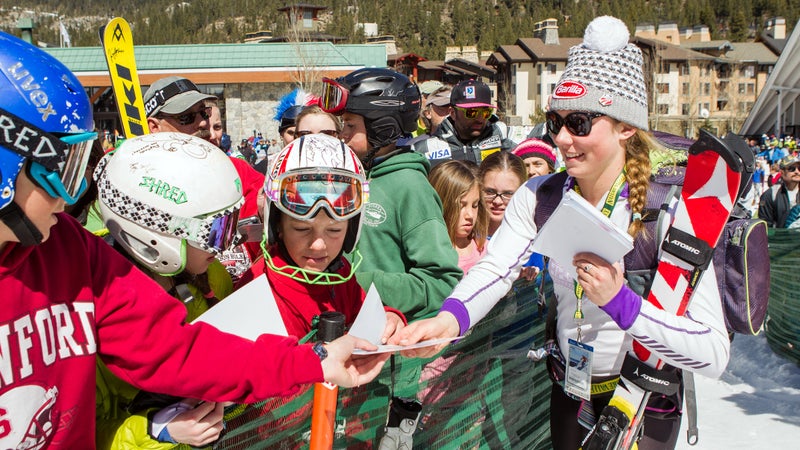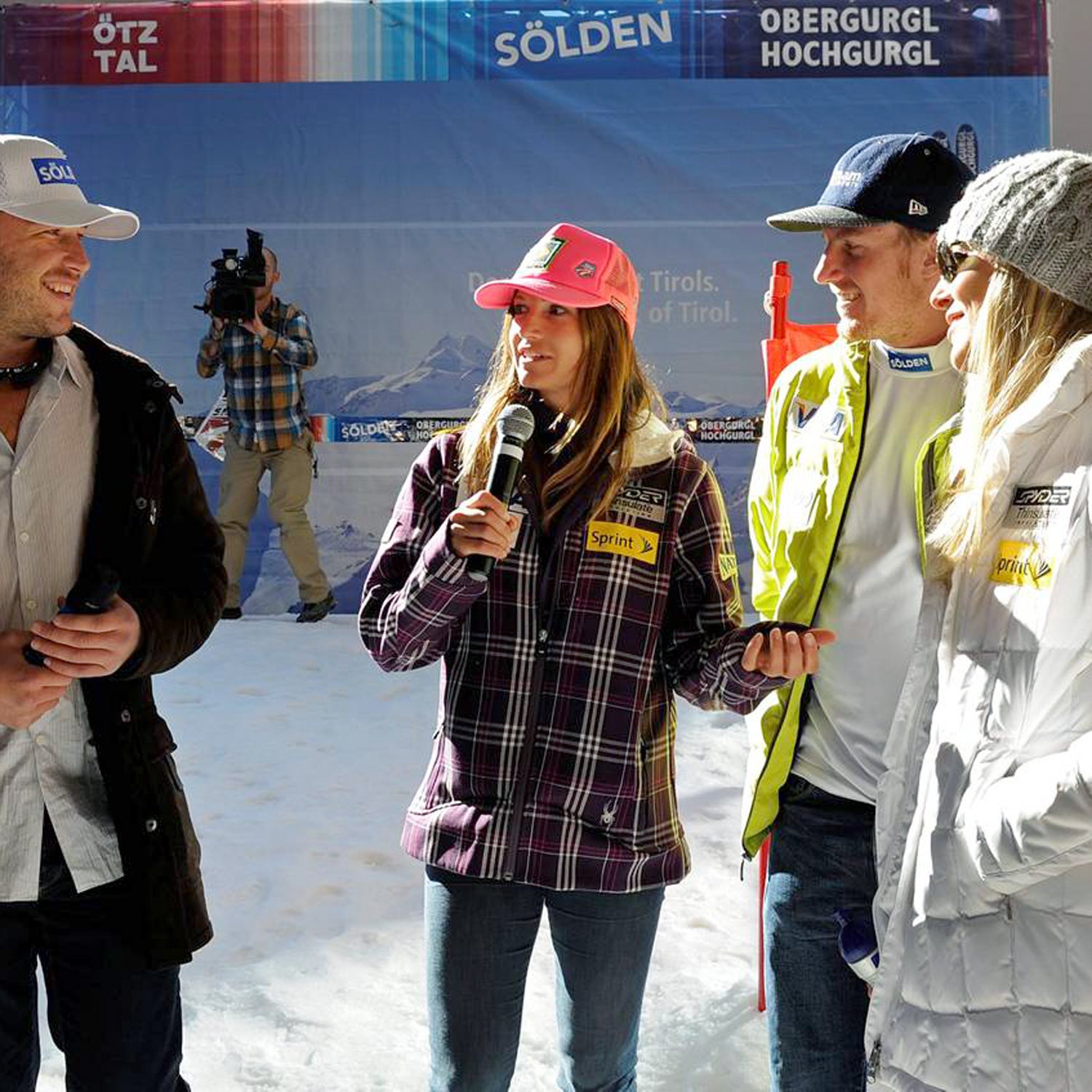On Tuesday, the Alpine world championships kicked off in Beaver Creek, Colorado. Featuring over 700 athletes from 70 countries competing over a two-week span, the biannual event is comparable to a mini Olympics, except the only sport on tap is ski racing. With Bode Miller, Lindsey Vonn, Julia Mancuso, Ted Ligety, and Mikaela Shiffrin, the U.S ski team heads into these world championships with one of the strongest teams in history.
Fresh off of her 64th victory in St. Moritz, Switzerland, and a third place in the super G at Beaver Creek, Lindsey Vonn has definitively announced that she’s back in prime form. Recovering from an ailing back that required surgery in November, Bode Miller, who has not raced this season, has confirmed that he will compete in the super G on Thursday and the downhill, and perhaps the combined.
Olympic gold medalist Mikaela Shiffrin has five World Cup podium finishes this season and is a favorite for a medal in the giant slalom and slalom. Julia Mancuso, Ted Ligety, and Andrew Weibrecht, along with Steven Nyman and Travis Ganong, who have nabbed three podium finishes between them this season, are in the hunt for medals, too.
[quote]“The U.S. team has a seat at the table on the tour. They know the formula for success—that wasn’t the case in the nineties.”[/quote]
There’s never been a better time for American ski racing, and this world championships could be an all-time medal haul for the U.S.
Coinciding with the world championships is the debut this week of sports journalist Nathaniel Vinton’s book, . The book serves up a superbly crafted account of how the U.S. ski team, led by Vonn, Miller, Mancuso, and Ligety, evolved from a D-list squad in the 1990s into a ski racing powerhouse by 2010, and how in the process, they changed the sport forever.
In honor of the world championships, we asked Vinton for some behind-the-scenes insight on ski racing and some its biggest stars.
OUTSIDE: Can you put Lindsey Vonn’s 63rd victory into context and talk a bit about Annemarie Moser-Proell, who previously held the record for most wins by a woman. Was it harder to accomplish this feat in Moser-Proell’s time or in our time?
VINTON: It’s fun to compare them and impossible to say when it was harder to accomplish. Moser-Proell is a fascinating figure to me. I found a copy of Ski Racing from 1975 that called her the sport’s “problem child” because of her squabbles with coaches, her indifference to training, and “a smoking habit that occasionally got out of control.”
But then I met her and she’s so dignified. One of my favorite pieces of research was a visit to the cafe in her hometown of Kleinarl that she opened up. She sold it, but her trophies are still there and they are so beautiful and strange. There was a silver axe that she won at a World Cup in Sugarloaf, Maine—a race called the Tall Timber Classic.
Do you think Mikaela Shiffrin will eclipse Vonn in terms of success and fame?
The scary thing about ski racing is the injury rate, especially in the speed events, where Shiffrin is heading. Shiffrin is a really special talent, but success like Vonn’s requires avoiding one of those unspeakable endings that I write a lot about in The Fall Line. Fame is a totally different thing. Shiffrin handles it well, like Lindsey, but personally I hope she also emulates Miller too, because for all of the drawbacks to the way he presents himself, he gets to live free, and that is so extremely rare in professional sports these days.

Do you think the U.S. will ever have another generation with same depth of talent and star power as we do today?
I don’t think the U.S. ski team is likely to slip back to the kind of condition it was in the mid-1990s. There were a few stars on the team back then, but a closer study shows how really bleak it was, a revolving door of executives, small and unreliable budgets, far less funding and no unified vision. People like Jeremy Nobis ditching the A team in favor of the pro tour. In 1996 the best American man on the World Cup finished 43rd in the season standings. The year after that, the men’s team didn’t earn a single GS point all season.
Then Bode Miller and Bill Marolt came along, and Lindsey Kildow and Julia Mancuso joined the development team. The Fall Line focuses a lot on how they all drove the team to evolve into something more professional, nimble, and assertive. I suspect that will remain after they’re gone. It would take a conscious effort to undo it. The U.S. team has a seat at the table on the tour. They know the formula for success—that wasn’t the case in the nineties.
Developing new racers is a huge challenge. But today they come into the team and are immediately benefiting from institutional knowledge. For instance, they train out of the team’s apartments in Soelden, Austria. Compare that to what Bode faced when he joined the team. When he and Erik Schlopy decided they wanted to get an apartment in Austria for better access to training, they met active resistance from the team. Coaches were opposed to it. They had to go out on their own and convince a trustee, Paul Fremont-Smith, to help make it happen.
Is Bode Miller intrinsically a good guy or a selfish guy?
The short answer is probably yes to both. Every top athlete has to be somewhat selfish, and it was especially important for Miller at the start of his career, when he joined a team that wasn’t really ready to provide what he needed.
I don’t think Miller ever sets out to hurt people. But he does have a very rare sort of absolute confidence that can make him seem blunt and disrespectful. And he truly cares less about what people think about him than anyone I’ve ever known.
If you’re asking if Miller can be a jerk, yes, I could tell you some stories. But he’s only human. In my book I call him the “anti-Lance” because he’s genuinely not interested in dominating his sport. He mainly wants to put on spectacular, inspiring performances. That makes him a showman, and that’s a fundamentally generous role.
Also, he helps a lot of people through his nonprofit foundation, the , many of them total strangers. His family places a lot of value on helping less fortunate people find a way to thrive. His grandfather was famous for it.
Based on your research, how do you think climate change might change ski racing?
They’ll be ski racing at St. Moritz, Lech, and Saas Fee when my kids have kids. Kitzbuehel is more vulnerable. But based on my research, climate change has already altered top-level ski racing, forcing organizers to ice every course in order to guarantee races. At current warming rates, winter is less and less certain at the places that produced Vonn and Miller—the upper Midwest and New England, two hotbeds of Alpine skiing that have nurtured the two greatest skiers in American history.
Why aren’t more Americans interested in ski racing as a sport and why should they be?
This book is steeped in the culture of the Alps, where the sport’s legends are born and where I spent so much time. The Austrians and Swiss have so much respect for ski racers and I wanted to help Americans understand why.
The U.S. ski team is one of the great success stories in sports, full of tremendous personalities and intrigue. I hear America likes winners, so I hope America reads the book.
This interview was edited and condensed for clarity.


